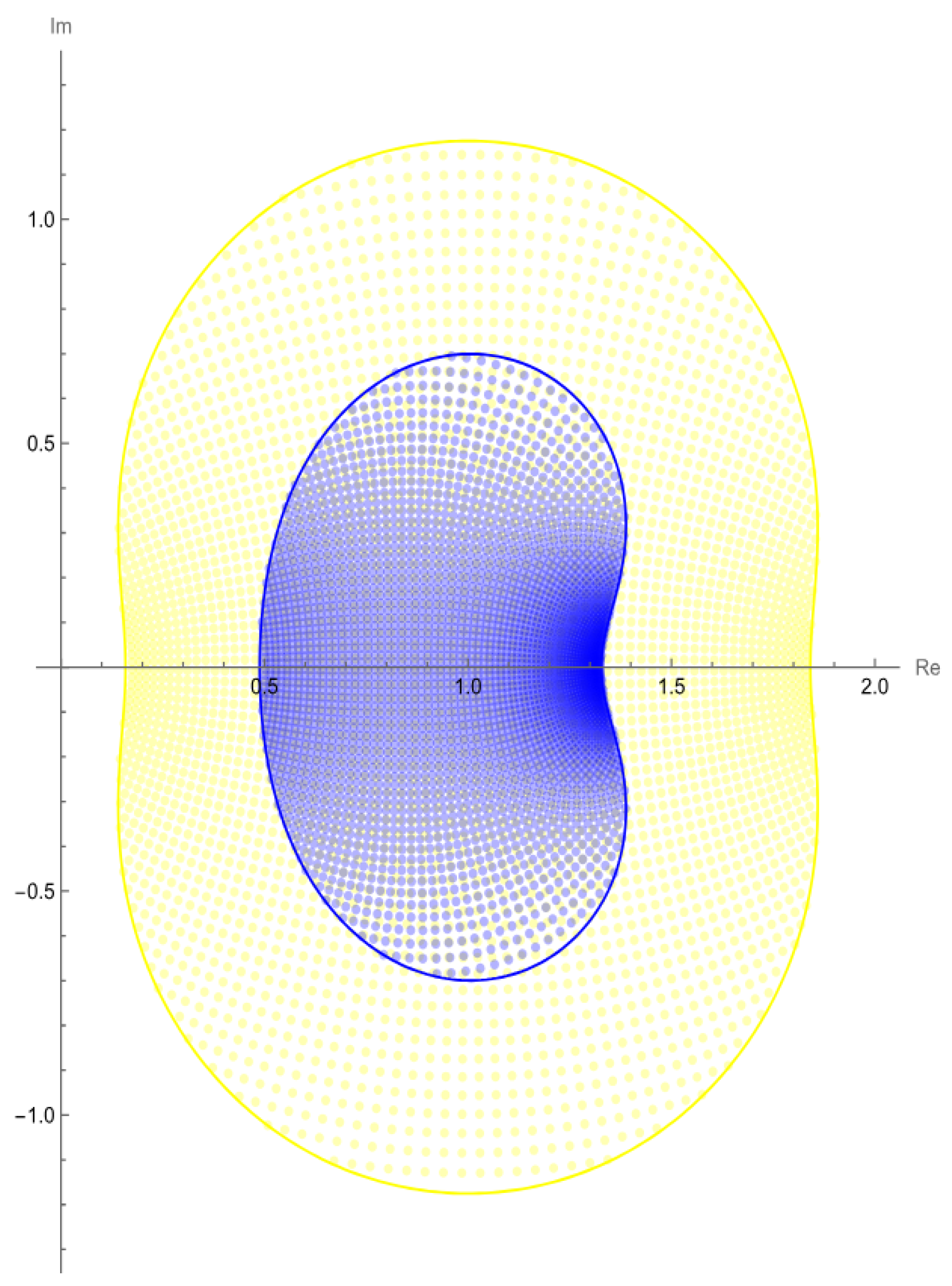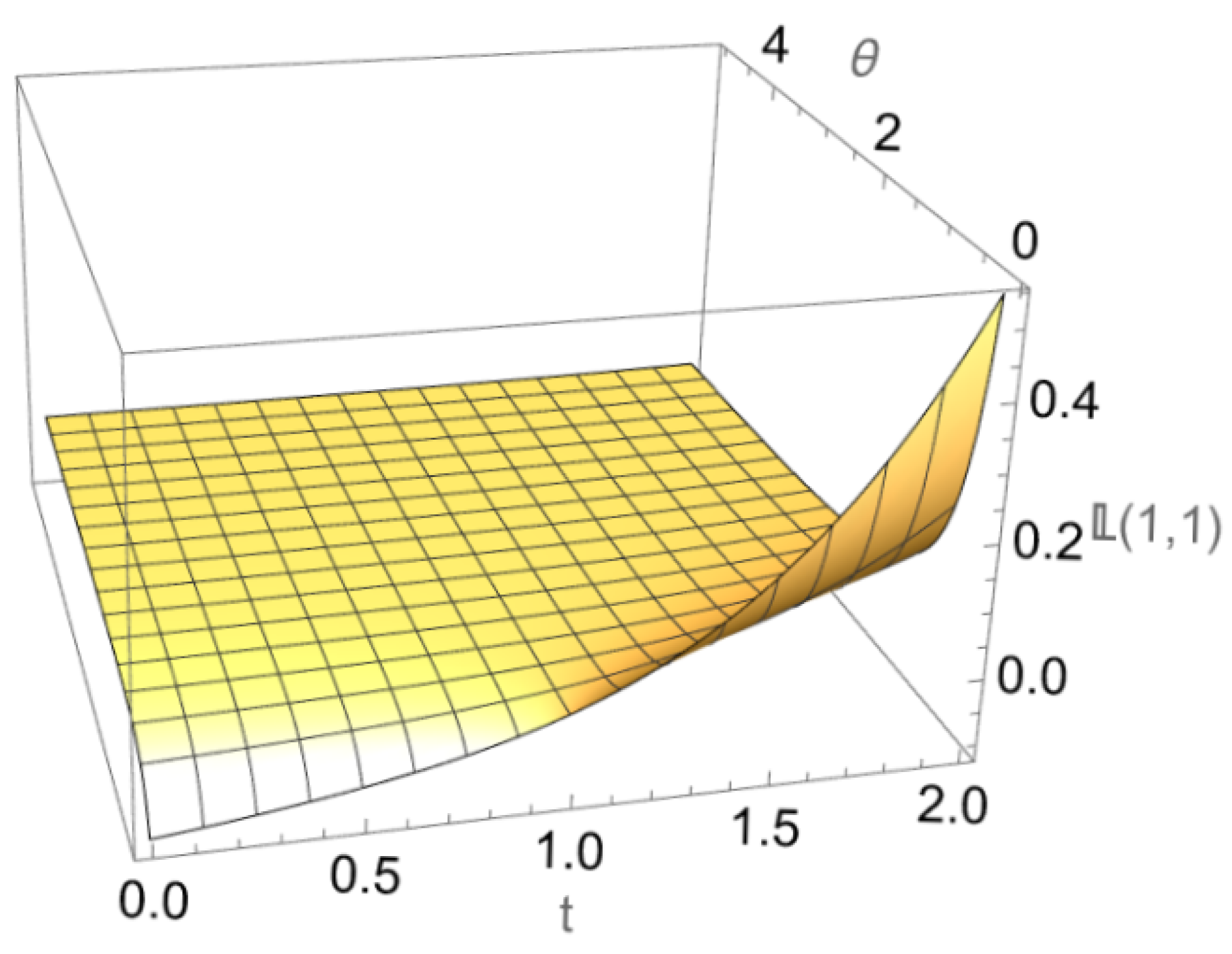Third-Order Hankel Determinant for a Class of Bi-Univalent Functions Associated with Sine Function
Abstract
1. Introduction
2. Definition and Lemmas
- (i)
- If , then the function f is said to belong to the class , and the definition simplifies to
- (ii)
- If , then the function f is said to belong to the class , and the subordination becomes
3. On the Second Hankel Determinant Associated with the Class
4. Third Hankel Determinant and Some Inequalities
5. Examples of the Main Results
6. Conclusions
Author Contributions
Funding
Data Availability Statement
Conflicts of Interest
References
- Mamon, M.A.; Halouani, B.; Elshazly, I.S.; Murugusundaramoorthy, G.; El-Qadeem, A.H. Second Hankel Determinant Bound Application to Certain Family of Bi-Univalent Functions. Axioms 2024, 13, 819. [Google Scholar] [CrossRef]
- El-Ityan, M.; Ali, S.Q.; Al-Hawary, T.; Rafid, B.; Breaz, D.; Luminita-Ioana, C. On the Third Hankel Determinant of a Certain Subclass of Bi-Univalent Functions Defined by (p, q)-Derivative Operator. Mathematics 2025, 13, 1269. [Google Scholar] [CrossRef]
- Hussen, A.; Illafe, M.; Zeyani, A. Fekete-Szegö and Second Hankel Determinant for a Certain Subclass of Bi-Univalent Functions associated with Lucas-Balancing Polynomials. Int. J. Neutrosophic Sci. 2025, 25, 417–434. [Google Scholar]
- Shakir, Q.A.; Atshan, W.G. On Third Hankel Determinant for Certain Subclass of Bi-Univalent Functions. Symmetry 2024, 16, 239. [Google Scholar] [CrossRef]
- Duren, P.L. Univalent Functions; Grundlehren der Mathematischen Wissenschaften, Band 259; Springer: New York, NY, USA; Berlin/Heidelberg, Germany; Tokyo, Japan, 1983. [Google Scholar]
- Alhily, S.S. Some Results on Koebe one-quarter theorem and Koebe distortion theorem. J. Iraqi Al-Khwarizmi Soc. 2018, 2, 29–38. [Google Scholar]
- Singh, S.; Singh, R. Subordination by univalent functions. Proc. Am. Math. Soc. 1981, 82, 39–47. [Google Scholar] [CrossRef]
- Dmitrishin, D.; Dyakonov, K.; Stokolos, A. Univalent polynomials and Koebe’s one-quarter theorem. Anal. Math. Phys. 2019, 9, 991–1004. [Google Scholar] [CrossRef]
- Yousef, F.; Frasin, B.A.; Al-Hawary, T. Fekete-Szegö Inequality for Analytic and Bi-univalent Functions Subordinate to Chebyshev Polynomials. Filomat 2018, 32, 3229–3236. [Google Scholar] [CrossRef]
- Srivastava, H.M.; Mishra, A.K.; Gochhayat, P. Certain subclasses of analytic and bi-univalent functions. Appl. Math. Lett. 2010, 23, 1188–1192. [Google Scholar] [CrossRef]
- Altinkaya, Ş.; Tokgöz, S.Y. Construction of the Second Hankel Determinant for a New Subclass of Bi-Univalent Functions. Turk. J. Math. 2018, 42, 2876–2884. [Google Scholar] [CrossRef]
- Zhang, L.; Wang, Z.; Shi, L. Sharp Bounds on Hankel Determinant of q-Starlike and q-Convex Functions Subordinate to Secant Hyperbolic Functions. Fractal Fract. 2025, 9, 346. [Google Scholar] [CrossRef]
- Illafe, M.; Mohd, M.H.; Yousef, F.; Supramaniam, S. Bounds for the Second Hankel Determinant of a General Subclass of Bi-Univalent Functions. Int. J. Math. Eng. Manag. Sci. 2024, 9, 1226. [Google Scholar] [CrossRef]
- Lewin, M. On a coefficient problem for bi-univalent functions. Proc. Am. Math. Soc. 1967, 18, 63–68. [Google Scholar] [CrossRef]
- Brannan, D.; Clunie, J. Aspects of Contemporary Complex Analysis; Academic Press: London, UK, 1980. [Google Scholar]
- Natanyahu, E. The minimal distance of the image boundary from the origin and the second coefficient of a univalent function in |z|<1. Arch. Ration. Mech. Anal. 1969, 32, 100–112. [Google Scholar]
- Hussen, A.; Madi, M.S.; Abominjil, A.M. Bounding coefficients for certain subclasses of bi-univalent functions related to Lucas-Balancing polynomials. AIMS Math. 2024, 9, 18034–18047. [Google Scholar] [CrossRef]
- Brannan, D.A.; Taha, T.S. On some classes of bi-univalent functions. Studia Univ. Babes-Bolyai Math. 1986, 31, 70–77. [Google Scholar]
- Al-Ityan, M.; Amourah, A.; Alsoboh, A.; Anakira, N.; Raba’a, M.B.; Hammad, S.; Sasa, T. Fekete-Szegö Inequalities for a New Class of Bi-Univalent Functions Defined via the Mittag-Leffler Function. Eur. J. Pure Appl. Math. 2025, 18, 6064. [Google Scholar] [CrossRef]
- Fekete, M.; Szegö, G. Eine bemerkung über ungerade schlichte funktionen. J. Lond. Math. Soc. 1933, 1, 85–89. [Google Scholar] [CrossRef]
- Tayyah, A.S.; Atshan, W.G.; Oros, G.I. Third-Order Differential Subordination Results for Meromorphic Functions Associated with the Inverse of the Legendre Chi Function via the Mittag-Leffler Identity. Mathematics 2025, 13, 2089. [Google Scholar] [CrossRef]
- Al-Hawary, T.; Illafe, M.; Yousef, F. Certain Constraints for Functions Provided by Touchard Polynomials. Int. J. Math. Math. Sci. 2025, 2025, 2581058. [Google Scholar] [CrossRef]
- Miller, S.S.; Mocanu, P.T. Second Order Differential Inequalities in the Complex Plane. J. Math. Anal. Appl. 1978, 65, 289–305. [Google Scholar] [CrossRef]
- Miller, S.S.; Mocanu, P.T. Differential Subordination: Theory and Applications; Marcel Dekker, Inc.: New York, NY, USA, 2000. [Google Scholar]
- Deniz, E. Certain subclasses of bi-univalent functions satisfying subordinate conditions. J. Class. Anal. 2013, 2, 49–60. [Google Scholar] [CrossRef]
- Abbas, M.; Alhefthi, R.K.; Ritelli, D.; Arif, M. Sharp Second-Order Hankel Determinant Bounds for Alpha-Convex Functions Connected with Modified Sigmoid Function. Axioms 2024, 13, 844–862. [Google Scholar] [CrossRef]
- Haji, N.H.; Buti, R.H.; Darwish, H.E. On a Class of Analytic Univalent Functions Associated with (HR) Fractional Derivative. Muthanna J. Pure Sci. 2024, 11, 94–99. [Google Scholar] [CrossRef]
- Tayyah, A.S.; Atshan, W.G. Starlikeness and Bi-Starlikeness Associated with a New Carathéodory Function. J. Math. Sci. 2025, in press. [Google Scholar] [CrossRef]
- Noonan, J.W.; Thomas, D.K. On the Second Hankel Determinant of Areally Mean p-Valent Functions. Trans. Am. Math. Soc. 1976, 223, 337–346. [Google Scholar] [CrossRef]
- Wang, Z.G.; Srivastava, H.M.; Arif, M.; Liu, Z.H.; Ullah, K. Sharp Bounds on Hankel Determinants of Bounded Turning Functions Involving the Hyperbolic Tangent Function. Appl. Anal. Discret. Math. 2024, 18, 551–571. [Google Scholar] [CrossRef]
- Srivastava, H.M.; Khan, N.; Bah, M.A.; Alahmade, A.; Tawfiq, F.M.; Syed, Z. Fourth Order Hankel Determinants for Certain Subclasses of Modified Sigmoid-Activated Analytic Functions Involving the Trigonometric Sine Function. J. Inequal. Appl. 2024, 2024, 84. [Google Scholar] [CrossRef]
- Sun, Y.; Wang, Z.G. The Second Hankel Determinants of Logarithmic Coefficients of Ma-Minda Type Functions. Bull. Korean Math. Soc. 2025, 62, 663–678. [Google Scholar]
- Lupaş, A.A.; Tayyah, A.S.; Sokół, J. Sharp Bounds on Hankel Determinants for Starlike Functions Defined by Symmetry with Respect to Symmetric Domains. Symmetry 2025, 17, 1244. [Google Scholar] [CrossRef]
- Shakir, Q.A.; Tayyah, A.S.; Breaz, D.; Cotîrlă, L.-I.; Rapeanu, E.; Sakar, F.M. Upper Bounds of the Third Hankel Determinant for Bi-Univalent Functions in Crescent-Shaped Domains. Symmetry 2024, 16, 1281. [Google Scholar] [CrossRef]
- Hadi, S.H.; Darus, M.; Alamri, B.; Altınkaya, Ş.; Alatawi, A. On Classes of ζ-Uniformly q-Analogue of Analytic Functions with Some Subordination Results. Appl. Math. Sci. Eng. 2024, 32, 2312803. [Google Scholar] [CrossRef]
- Altınkaya, S.; Magesh, N.; Yalçın, S. Construction of Toeplitz Matrices Whose Elements Are the Coefficients of Univalent Functions Associated with Q-Derivative Operator. Casp. J. Math. Sci. 2019, 8, 51–57. [Google Scholar]
- El-Ityan, M.; Al-Hawary, T.; Frasin, B.A.; Aldawish, I. A New Subclass of Bi-Univalent Functions Defined by Subordination to Laguerre Polynomials and the (p, q)-Derivative Operator. Symmetry 2025, 17, 982. [Google Scholar] [CrossRef]
- Vijayalakshmi, S.P.; Yalçın, S.; Sudharsan, T.V. Sharp Estimates of Hermitian Toeplitz Determinants for Some Subclasses of Sakaguchi Type Function Related to Sine Function. Sahand Commun. Math. Anal. 2025, 22, 175–191. [Google Scholar]
- Nandhini, B.; Sruthakeerthi, B. On Sharp Estimates of the Bounded Turning Functions Associated with a Bean Shaped Domain. Complex Anal. Oper. Theory 2025, 19, 36. [Google Scholar] [CrossRef]
- Grenander, U.; Szegö, G. Toeplitz Forms and Their Applications; California Monographs in Mathematical Sciences; University California Press: Berkeley, CA, USA, 1958. [Google Scholar]



Disclaimer/Publisher’s Note: The statements, opinions and data contained in all publications are solely those of the individual author(s) and contributor(s) and not of MDPI and/or the editor(s). MDPI and/or the editor(s) disclaim responsibility for any injury to people or property resulting from any ideas, methods, instructions or products referred to in the content. |
© 2025 by the authors. Licensee MDPI, Basel, Switzerland. This article is an open access article distributed under the terms and conditions of the Creative Commons Attribution (CC BY) license (https://creativecommons.org/licenses/by/4.0/).
Share and Cite
El-Ityan, M.; Sabri, M.A.; Hammad, S.; Frasin, B.; Al-Hawary, T.; Yousef, F. Third-Order Hankel Determinant for a Class of Bi-Univalent Functions Associated with Sine Function. Mathematics 2025, 13, 2887. https://doi.org/10.3390/math13172887
El-Ityan M, Sabri MA, Hammad S, Frasin B, Al-Hawary T, Yousef F. Third-Order Hankel Determinant for a Class of Bi-Univalent Functions Associated with Sine Function. Mathematics. 2025; 13(17):2887. https://doi.org/10.3390/math13172887
Chicago/Turabian StyleEl-Ityan, Mohammad, Mustafa A. Sabri, Suha Hammad, Basem Frasin, Tariq Al-Hawary, and Feras Yousef. 2025. "Third-Order Hankel Determinant for a Class of Bi-Univalent Functions Associated with Sine Function" Mathematics 13, no. 17: 2887. https://doi.org/10.3390/math13172887
APA StyleEl-Ityan, M., Sabri, M. A., Hammad, S., Frasin, B., Al-Hawary, T., & Yousef, F. (2025). Third-Order Hankel Determinant for a Class of Bi-Univalent Functions Associated with Sine Function. Mathematics, 13(17), 2887. https://doi.org/10.3390/math13172887





